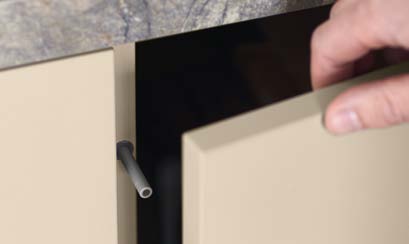European-style handless kitchens have gained tremendous popularity in kitchen design in recent years. Renowned for their sleek and minimalist aesthetics, these kitchens combine innovative functionality, exceptional craftsmanship, and cutting-edge design. In this blog post, we will explore the essence of European-style handless kitchens and delve into the world of the best European cabinet manufacturers, from Italian to German kitchen cabinets.
European cabinets are renowned for their clean lines, seamless appearance, and effortless functionality. This design philosophy creates a sleek look by eliminating traditional hardware such as handles and knobs. But there is more than one way to achieve this outward appearance, and only one qualifies as ‘true,’ whereas we can call the other methods’ suboptimal.’

There are two ways that manufacturers achieve the look of handleless kitchen cabinets that are ok, but not the best, from a functional perspective: an integrated handle or a push-to-open design.
1. Handleless Kitchen Cabinets Suboptimal Methods; Integrated Handles

An integrated handle is hardware attached to the door or drawer face, such as a jay or tab pull. While this method uses the same soft-close hardware as a true handleless design, there are downsides.
First, the depth of the handle is relatively shallow, so those with longer fingernails may find these pulls uncomfortable to operate, as there is a shallow metal backing when grabbing hold of the door or drawer. Also, this design has limited color options, typically either stainless steel or matte black.
2. Suboptimal Handleless Cabinet Design; Push-to-Open

The second suboptimal handleless cabinetry design is called push-to-open, and it is the most commonly used method in the US when trying to mimic the look of authentic handleless European modern kitchen cabinetry. This cabinet style uses hardware inside the box, so pushing the door or drawer inward pops the door out with a spring-like function. Where this design is ok for doors used infrequently, there are multiple downsides for more heavily used doors.
First, fingerprints. When operating the door, all that pushing to open and pushing to close leaves its mark. For glossy or darker finishes, this can be frustrating, and with more delicate finishes, repeated use can cause permanent spots on the door faces.
A second downside is that soft close hinges cannot be used with this type of closure system, so closing doors becomes more of a chore, as the internal hardware needs to be fully engaged back to its original position each time; you cannot just slam a door closed.
Lastly, one needs to know where to push the face of the cabinet to open it. When not engaged in the right spot, the door will not open. Even for someone familiar with the kitchen cabinetry layout, this can be unclear when there are many doors.
True Handleless Cabinetry; The Groove

The real and true method for handleless European kitchen designs uses a groove. Instead of being attached to the door or drawer, a metal channel, or groove, is inset into the cabinet box, so the door can remain as it is, with no handle and a simple square edge on all four sides. There are numerous benefits to this design, and why it is considered the gold standard among all of the options.
First is the purchase. In this case, ‘purchase’ refers to the ‘grab-ability’ of the door or drawer, not the cost. With a built-in groove, the door is almost effortless to open by reaching inside just behind the face. This operation leads to another benefit: no fingerprints.

Another upside is that groove-design uses the best German soft-close hardware in all situations. With the push-to-open cabinetry design, this is different. When cabinets have an inset groove, one can slam doors and drawers closed, and they will retract with a smooth and silent operation.
Lastly, with the best Italian cabinets and German cabinetry manufacturers, custom colors can be applied to the groove itself, which expands design options in a major way.
The Best European Cabinet Manufacturers
When it comes to European kitchen cabinets, several manufacturers stand out for their commitment to quality, innovation, and design excellence. Let’s explore a few renowned European cabinet manufacturers:
Italian Kitchen Cabinets: Italian craftsmanship is synonymous with sophistication and luxury. Italian kitchen cabinets are known for their impeccable attention to detail, exquisite finishes, and timeless design. Brands such as TM Italia, Scavolini, and Binova are recognized for their exceptional Italian kitchen cabinets that effortlessly blend style and functionality.
German Kitchen Cabinets: German engineering has long been revered for its precision and efficiency. German kitchen cabinets exhibit these qualities, boasting high-quality materials, innovative storage solutions, and ergonomic design. Companies like SieMatic, Poggenpohl, and Beckermann are renowned for their impeccable German kitchen cabinets that merge minimalist aesthetics with functional excellence.
Modern Handleless European Kitchen Design
European handless kitchens epitomize modern elegance, combining functionality, aesthetics, and superior craftsmanship. The best European cabinet manufacturers have mastered the art of creating kitchen spaces that are not only visually stunning but also highly functional. Whether you seek a minimalist sanctuary or a sleek space for culinary creativity, European-style cabinets offer an exceptional blend of style and convenience that is hard to match. Embrace the allure of European design and transform your kitchen into a haven of contemporary elegance.







Comentários